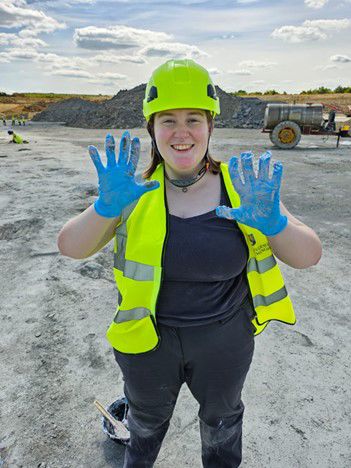Digging for Dinosaurs - Rune's Story
 Getting "hands-on" at the dig site
Getting "hands-on" at the dig site
We caught up with Rune, a 3rd year Palaeontology student, who was lucky enough to take part in what's become a world famous dinosaur dig.
'Last summer I took part in a dig in Oxfordshire where we uncovered the UK’s largest dinosaur track site. The dig was carried out by UoB, in collaboration with the amazing team from the Oxford Natural History Museum, and I was able to get involved and spend a day working the site in the middle of the dig thanks to my brilliant lecturers, Prof. Richard Butler and Prof. Kirsty Edgar.
'The track site has been all over the news recently, as well as featuring on Digging for Britain; it deserves the attention it has received. Made in the heart of the Jurassic, about 166 million years ago in a tropical lagoon, these 200 prints in five different trackways extend at least 150m over the quarry floor. Four of these tracks were made by sauropods (huge, four-legged, long-necked dinosaurs) which reached a peak of diversity in the Jurassic. We think these prints were made by Cetiosaurus. The last trackway is thought to have been made by Megalosaurus – the largest British predator of its time. Megalosaurus was 6-9m in length and was the first dinosaur to be described way back in 1824. I think it's quite a nice twist of fate that this site was discovered in 2024, 200 years after its initial description, and it was so special for me to be working during such a special anniversary.
'I started the day out by working on photogrammetry – a technique where hundreds of photos of an object are taken at different heights and orientations are layered to produce a 3D image. It’s an invaluable technique for a site that’s prone to erosion; we can preserve the detail forever in these models and make the study of the site much more accessible. Over 20,000 photos were taken of the whole site, with hundreds of photos required for each print. I mostly worked on the big sauropod tracks, as these had been properly excavated and cleaned out by the time I arrived on site. I took nearly endless photos at different heights, circling the print like a vulture. I used a scale bar to provide essential context, noting which photos were of each footprint to make the reconstruction easier later.
'This took much of the morning, and I had just finished lunch when I volunteered to finish casting up a footprint. Casting has multiple uses, such as creating a plaster jacket to protect a specimen when hauling it out of the ground, to preserve detail and act as a mould for future reproductions. Here, we were using casting for the second method. For this print I joined in the later stages – where layers of burlap, soaked in plaster of Paris, are smoothed over the contours of the print impression to give a firm support for the detail and successive mould. This print is very special. It shows a crossover, where a Megalosaurus stepped on top of where a Sauropod had, preserving their interaction forever. This was so exciting to work on, a print so gorgeously preserved it captured the moment in perfect detail. Just a short while later, I got a chance to do the first stages of casting on one of the sauropod prints I’d been conducting photogrammetry with earlier in the day. Using hands and paintbrushes, the other volunteers and I smeared a thin layer of liquid plastic all over the print. When that had dried, we added two more layers, each getting thicker. This coating of liquid plastic picks up all the details from the print, and once successive layers of plaster are laid over it, the print is left undamaged when the cast is removed.
'To finish the day, I turned my hand to excavating. There was still plenty of mud to clear out of prints and a lot of cleaning to do; as they say, a clean quarry is a happy quarry! I was working on a print at the far end of the quarry, using awls and brushes to clean out the impression and get down to the bed rock. It's interesting work, seeing the shape of the print come alive under your hands and revealing detail, chip by chip. Just be sure to watch the back of your neck, dig sunburn is a real hazard!
'This was such a special experience for me, partly because of the anniversary I mentioned, but also because of how involved I was able to get as a student. All students know how hard experience can be to come by, so it was pretty special to be trusted and involved in this way by the department. I feel like field work is a huge part of our learning here (I mean, they did take us to Utah to dig Ankylosaurs after all) but being involved in such a huge new find as this was definitely a unique experience I’ll never forget.'